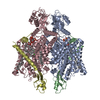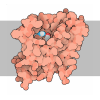+ データを開く
データを開く
- 基本情報
基本情報
| 登録情報 | データベース: PDB / ID: 9do0 | |||||||||||||||||||||||||||
|---|---|---|---|---|---|---|---|---|---|---|---|---|---|---|---|---|---|---|---|---|---|---|---|---|---|---|---|---|
| タイトル | Human ClC-3 | |||||||||||||||||||||||||||
 要素 要素 | H(+)/Cl(-) exchange transporter 3 | |||||||||||||||||||||||||||
 キーワード キーワード | MEMBRANE PROTEIN / Ion channel / lysosomal protein / CLC | |||||||||||||||||||||||||||
| 機能・相同性 |  機能・相同性情報 機能・相同性情報volume-sensitive chloride channel activity / chloride:proton antiporter activity / synaptic vesicle lumen acidification / negative regulation of cell volume / endosomal lumen acidification / regulation of pH / voltage-gated chloride channel activity / specific granule / photoreceptor cell maintenance / vesicle membrane ...volume-sensitive chloride channel activity / chloride:proton antiporter activity / synaptic vesicle lumen acidification / negative regulation of cell volume / endosomal lumen acidification / regulation of pH / voltage-gated chloride channel activity / specific granule / photoreceptor cell maintenance / vesicle membrane / antiporter activity / phagocytosis, engulfment / synaptic transmission, GABAergic / chloride channel activity / positive regulation of reactive oxygen species biosynthetic process / phagocytic vesicle / axon terminus / chloride transmembrane transport / secretory granule / adult locomotory behavior / synaptic transmission, glutamatergic / PDZ domain binding / recycling endosome / GABA-ergic synapse / Stimuli-sensing channels / ruffle membrane / synaptic vesicle / synaptic vesicle membrane / late endosome membrane / late endosome / cytoplasmic vesicle / early endosome membrane / early endosome / endosome membrane / Golgi membrane / lysosomal membrane / external side of plasma membrane / intracellular membrane-bounded organelle / glutamatergic synapse / cell surface / Golgi apparatus / ATP binding / membrane / plasma membrane 類似検索 - 分子機能 | |||||||||||||||||||||||||||
| 生物種 |  Homo sapiens (ヒト) Homo sapiens (ヒト) | |||||||||||||||||||||||||||
| 手法 | 電子顕微鏡法 / 単粒子再構成法 / クライオ電子顕微鏡法 / 解像度: 2.54 Å | |||||||||||||||||||||||||||
 データ登録者 データ登録者 | Schrecker, M. / Son, Y. / Hite, R.K. | |||||||||||||||||||||||||||
| 資金援助 |  米国, 2件 米国, 2件
| |||||||||||||||||||||||||||
 引用 引用 |  ジャーナル: Nat Struct Mol Biol / 年: 2025 ジャーナル: Nat Struct Mol Biol / 年: 2025タイトル: Structural basis of ClC-3 transporter inhibition by TMEM9 and PtdIns(3,5)P. 著者: Marina Schrecker / Yeeun Son / Rosa Planells-Cases / Sumanta Kar / Viktoriia Vorobeva / Uwe Schulte / Bernd Fakler / Thomas J Jentsch / Richard K Hite /   要旨: The trafficking and activity of endosomes relies on the exchange of chloride ions and protons by members of the CLC family of chloride channels and transporters; mutations of the genes encoding these ...The trafficking and activity of endosomes relies on the exchange of chloride ions and protons by members of the CLC family of chloride channels and transporters; mutations of the genes encoding these transporters are associated with numerous diseases. Despite their critical roles, the mechanisms by which CLC transporters are regulated are poorly understood. Here we show that two related accessory β-subunits, TMEM9 and TMEM9B, directly interact with ClC-3, ClC-4 and ClC-5. Cryo-electron microscopy structures reveal that TMEM9 inhibits ClC-3 by sealing the cytosolic entrance to the Cl ion pathway. Unexpectedly, we find that phosphatidylinositol 3,5-bisphosphate (PtdIns(3,5)P) stabilizes the interaction between TMEM9 and ClC-3 and is required for proper regulation of ClC-3 by TMEM9. Collectively, our findings reveal that TMEM9 and PtdIns(3,5)P collaborate to regulate endosomal ion homeostasis by modulating the activity of ClC-3. #1: ジャーナル: bioRxiv / 年: 2025 タイトル: Structural basis of ClC-3 inhibition by TMEM9 and PI(3,5)P. 著者: Marina Schrecker / Yeeun Son / Rosa Planells-Cases / Sumanta Kar / Viktoriia Vorobeva / Uwe Schulte / Bernd Fakler / Thomas J Jentsch / Richard K Hite /   要旨: The trafficking and activity of endosomes relies on the exchange of chloride ions and protons by members of the CLC family of chloride channels and transporters, whose mutations are associated with ...The trafficking and activity of endosomes relies on the exchange of chloride ions and protons by members of the CLC family of chloride channels and transporters, whose mutations are associated with numerous diseases. Despite their critical roles, the mechanisms by which CLC transporters are regulated are poorly understood. Here, we show that two related accessory β-subunits, TMEM9 and TMEM9B, directly interact with ClC-3, -4 and -5. Cryo-EM structures reveal that TMEM9 inhibits ClC-3 by sealing the cytosolic entrance to the Cl ion pathway. Unexpectedly, we find that PI(3,5)P stabilizes the interaction between TMEM9 and ClC-3 and is required for proper regulation of ClC-3 by TMEM9. Collectively, our findings reveal that TMEM9 and PI(3,5)P collaborate to regulate endosomal ion homeostasis by modulating the activity of ClC-3. | |||||||||||||||||||||||||||
| 履歴 |
|
- 構造の表示
構造の表示
| 構造ビューア | 分子:  Molmil Molmil Jmol/JSmol Jmol/JSmol |
|---|
- ダウンロードとリンク
ダウンロードとリンク
- ダウンロード
ダウンロード
| PDBx/mmCIF形式 |  9do0.cif.gz 9do0.cif.gz | 524.2 KB | 表示 |  PDBx/mmCIF形式 PDBx/mmCIF形式 |
|---|---|---|---|---|
| PDB形式 |  pdb9do0.ent.gz pdb9do0.ent.gz | 438.8 KB | 表示 |  PDB形式 PDB形式 |
| PDBx/mmJSON形式 |  9do0.json.gz 9do0.json.gz | ツリー表示 |  PDBx/mmJSON形式 PDBx/mmJSON形式 | |
| その他 |  その他のダウンロード その他のダウンロード |
-検証レポート
| 文書・要旨 |  9do0_validation.pdf.gz 9do0_validation.pdf.gz | 1.5 MB | 表示 |  wwPDB検証レポート wwPDB検証レポート |
|---|---|---|---|---|
| 文書・詳細版 |  9do0_full_validation.pdf.gz 9do0_full_validation.pdf.gz | 1.5 MB | 表示 | |
| XML形式データ |  9do0_validation.xml.gz 9do0_validation.xml.gz | 54.4 KB | 表示 | |
| CIF形式データ |  9do0_validation.cif.gz 9do0_validation.cif.gz | 80.8 KB | 表示 | |
| アーカイブディレクトリ |  https://data.pdbj.org/pub/pdb/validation_reports/do/9do0 https://data.pdbj.org/pub/pdb/validation_reports/do/9do0 ftp://data.pdbj.org/pub/pdb/validation_reports/do/9do0 ftp://data.pdbj.org/pub/pdb/validation_reports/do/9do0 | HTTPS FTP |
-関連構造データ
| 関連構造データ |  47070MC  9dnwC  9dnxC  9dnyC  9dnzC M: このデータのモデリングに利用したマップデータ C: 同じ文献を引用 ( |
|---|---|
| 類似構造データ | 類似検索 - 機能・相同性  F&H 検索 F&H 検索 |
- リンク
リンク
- 集合体
集合体
| 登録構造単位 | 
|
|---|---|
| 1 |
|
- 要素
要素
| #1: タンパク質 | 分子量: 91054.977 Da / 分子数: 2 / 由来タイプ: 組換発現 / 由来: (組換発現)  Homo sapiens (ヒト) / 遺伝子: CLCN3 / 発現宿主: Homo sapiens (ヒト) / 遺伝子: CLCN3 / 発現宿主:  Homo sapiens (ヒト) / 参照: UniProt: P51790 Homo sapiens (ヒト) / 参照: UniProt: P51790#2: 化合物 | ChemComp-CL / #3: 化合物 | ChemComp-CLR / #4: 水 | ChemComp-HOH / | 研究の焦点であるリガンドがあるか | Y | Has protein modification | Y | |
|---|
-実験情報
-実験
| 実験 | 手法: 電子顕微鏡法 |
|---|---|
| EM実験 | 試料の集合状態: PARTICLE / 3次元再構成法: 単粒子再構成法 |
- 試料調製
試料調製
| 構成要素 | 名称: Human ClC-3 / タイプ: COMPLEX / Entity ID: #1 / 由来: RECOMBINANT | |||||||||||||||||||||||||
|---|---|---|---|---|---|---|---|---|---|---|---|---|---|---|---|---|---|---|---|---|---|---|---|---|---|---|
| 分子量 | 実験値: NO | |||||||||||||||||||||||||
| 由来(天然) | 生物種:  Homo sapiens (ヒト) Homo sapiens (ヒト) | |||||||||||||||||||||||||
| 由来(組換発現) | 生物種:  Homo sapiens (ヒト) Homo sapiens (ヒト) | |||||||||||||||||||||||||
| 緩衝液 | pH: 8 詳細: 0.02% GDN, 50 mM Tris-HCl (pH 8), 150 mM KCl, 2 mM DTT | |||||||||||||||||||||||||
| 緩衝液成分 |
| |||||||||||||||||||||||||
| 試料 | 濃度: 3 mg/ml / 包埋: NO / シャドウイング: NO / 染色: NO / 凍結: YES | |||||||||||||||||||||||||
| 試料支持 | グリッドの材料: GOLD / グリッドのサイズ: 400 divisions/in. / グリッドのタイプ: Quantifoil R1.2/1.3 | |||||||||||||||||||||||||
| 急速凍結 | 装置: FEI VITROBOT MARK IV / 凍結剤: ETHANE / 湿度: 100 % / 凍結前の試料温度: 297 K |
- 電子顕微鏡撮影
電子顕微鏡撮影
| 実験機器 |  モデル: Titan Krios / 画像提供: FEI Company |
|---|---|
| 顕微鏡 | モデル: FEI TITAN KRIOS |
| 電子銃 | 電子線源:  FIELD EMISSION GUN / 加速電圧: 300 kV / 照射モード: FLOOD BEAM FIELD EMISSION GUN / 加速電圧: 300 kV / 照射モード: FLOOD BEAM |
| 電子レンズ | モード: BRIGHT FIELD / 最大 デフォーカス(公称値): 2000 nm / 最小 デフォーカス(公称値): 700 nm |
| 撮影 | 平均露光時間: 3 sec. / 電子線照射量: 66 e/Å2 / フィルム・検出器のモデル: GATAN K3 (6k x 4k) |
- 解析
解析
| EMソフトウェア |
| |||||||||||||||||||||||||||
|---|---|---|---|---|---|---|---|---|---|---|---|---|---|---|---|---|---|---|---|---|---|---|---|---|---|---|---|---|
| CTF補正 | タイプ: PHASE FLIPPING AND AMPLITUDE CORRECTION | |||||||||||||||||||||||||||
| 粒子像の選択 | 選択した粒子像数: 1446105 | |||||||||||||||||||||||||||
| 3次元再構成 | 解像度: 2.54 Å / 解像度の算出法: FSC 0.143 CUT-OFF / 粒子像の数: 219662 / 対称性のタイプ: POINT | |||||||||||||||||||||||||||
| 原子モデル構築 | プロトコル: BACKBONE TRACE / 空間: REAL / Target criteria: FSC 0.5 | |||||||||||||||||||||||||||
| 拘束条件 |
|
 ムービー
ムービー コントローラー
コントローラー







 PDBj
PDBj











